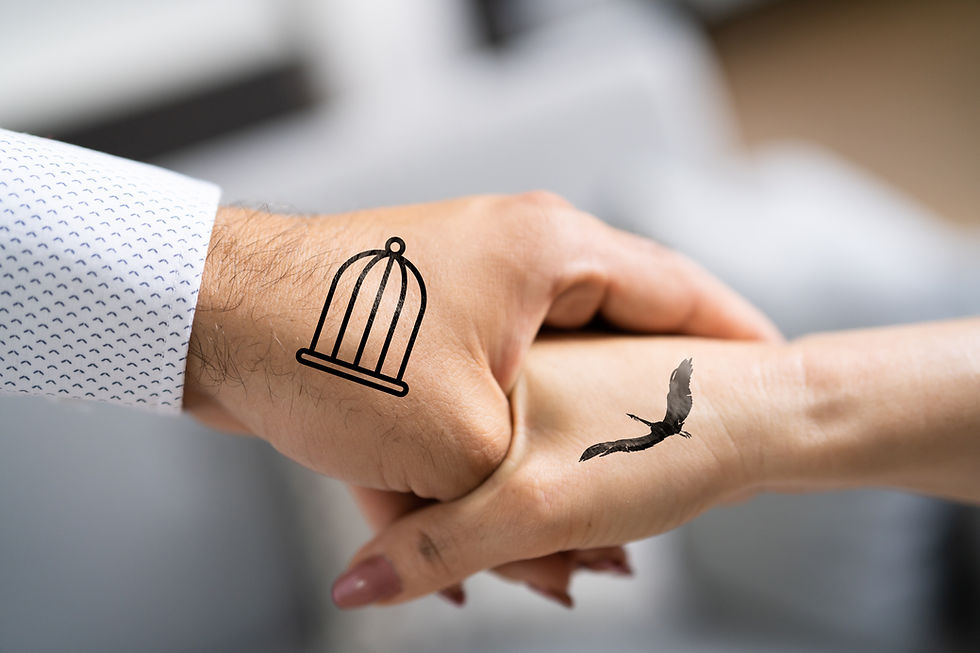Recognizing and Changing Codependency
How Do You Know If You're Codependent? Causes, Partner Choice, and Your Path to Independence
Codependency is a complex and often unnoticed pattern in relationships in which your identity, self-worth and well-being largely depend on helping or caring for others. Often this feels like love or devotion, but codependency can actually drain you and hinder your own growth. In my practice I see many people who may recognize themselves in this pattern. That is why I want to briefly explain in this blog what it means to be codependent, how to recognize whether you are, and how you can change this dynamic.

What is Codependency?
Codependency is a pattern of putting aside your own needs and boundaries for the sake of another, usually out of a deep need for approval, validation, or control. It can manifest in relationships with partners, family members, or friends. It goes beyond simply helping; it means that your self-worth depends on how well you care for another person, and that you often go beyond your own boundaries to please them.
How Do You Know If You Are Codependent?
It is a term that is perhaps not very well known and I had never heard of it myself until I started my training as a therapist. I did know the signals and I also knew that it was due to my need for confirmation or the feeling of wanting to be needed or to be able to 'save' someone. Below I have described a number of common signals:
You are constantly concerned with the needs of others , even if it is at your own expense.
You feel responsible for your partner's well-being and think that their happiness depends on you.
You find it difficult to say no and set boundaries.
You constantly seek confirmation from your partner and fear rejection.
You often feel empty, unhappy or exhausted in the relationship, because you give a lot and receive little.
You have difficulty with your own emotions and focus mainly on those of your partner.
If these points sound familiar to you, you may be in a codependent pattern.
What Causes Codependency?
Codependency often has its roots in childhood. For example:
Growing up in a dysfunctional family , where as a child you had to grow up too early or take on the role of 'caregiver'.
Being raised by emotionally unavailable parents , who made you feel like you had to 'earn' love by giving, caring, or solving problems.
Low self-esteem or insecurity that leads you to seek your worth externally, often by making others happy.
What Type of Partner Do You Choose if You're Codependent?
Codependents often attract partners who reinforce their need for care and validation. This may be a partner who:
Emotionally unavailable or narcissistic is someone who needs a lot of your attention and care, without really giving anything back.
Have addiction problems or other destructive habits that make you feel needed as a 'rescuer' or helper.
Exerts control or power over you , which may make you feel like you have to work hard to earn love or appreciation.
These types of partners reinforce dependency and can keep you trapped in the codependent pattern.
How Can You Go From Codependent to Independent?
Fortunately, change is possible. Here are some steps to help you transform from codependency to healthy independence:
1. Become Aware of Your Patterns
It starts with awareness. Understand how and why you got into codependent patterns. This can be done through self-reflection, therapy, or by reading books and articles about codependency.
2. Learn to Set Boundaries
Boundaries are essential to a healthy relationship. Start small, by recognizing your own needs and learning to say “no” when something doesn’t feel right. This may be uncomfortable at first, but it’s crucial to your emotional health.
3. Work on your Self-Love and Self-Esteem
Developing a sense of self-worth that is independent of others is an important step. This may involve working on your self-confidence, learning to value yourself for who you are rather than what you do for others.
4. Practice Self-Care
Take care of yourself physically, emotionally and mentally. This can be done by taking time for yourself, developing healthy habits and prioritizing your own needs.
5. Seek Support
It can be helpful to talk to a therapist or coach who specializes in codependency. This can help you break old patterns and develop new, healthy relationship patterns.
6. Choose Healthy Relationships
Learn the difference between healthy and unhealthy relationships. A healthy relationship is based on mutual respect, space for personal growth and emotional support without sacrificing yourself.
Conclusion
Codependency can be deeply ingrained, but it is possible to break these patterns. By becoming aware of your behavior, setting boundaries, and working on your self-esteem, you can take steps toward a healthier and more fulfilling relationship with yourself and others. The path to independence begins with self-love and the courage to choose what is right for you.
This process is a journey, not a destination, but each step brings you closer to a life where you learn to see yourself as a priority.
Do you want to take the first step towards a life of freedom? Book an appointment now:
_.png)
Comments